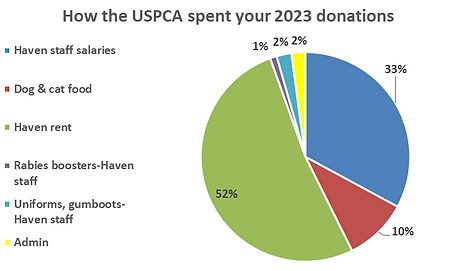AKI Partner Organization-Uganda Society for the Protection and Care of Animals (USPCA)

AKI's Partnership with Uganda Society for the Protection & Care of Animals

"Without all your [AKI] support and donors, I am not sure if the USPCA would still exist today!" (A USPCA Executive Committee member)
READ USPCA'S 2022 ANNUAL REPORT HERE.
The Uganda SPCA Haven is home to over 350 dogs and cats. Typically the USPCA helps more than 1000 animals every year-rescuing them from the street, from abusive situations, taking in animals who have been injured, animals left behind to fend for themselves (and even to starve) when their owners leave and leave them behind. Through their community work, the USPCA helps an additional ~ 1000 cats and dogs to remain healthy, spayed/neutered, and in their home or community.
Donations to Animal-Kind International support the costs to run the USPCA shelter, including rent, staff salaries, cat and dog food, shelter and vet supplies, transport, and spay/neuter.
In December 2023, we created the Elaine Law Memorial Pet Food Fund to raise money so that the USPCA's rescued dogs and cats will always have ample, nutritious meals! Named after a friend of AKI, who was a true animal lover and whose husband created this fund in her memory, we hope to provide a sustaining source of funds to the USPCA to purchase pet food.
You can donate to the USPCA Pet Food Fund on this page: designate Pet Food Fund on the donation form to the right.------>


The Haven is located at 12 Ismail Road in Mbuya, Kampala. Jackie (pictured above preparing a vaccination) is the Assistant Manager.

Use the Donorbox form to donate through PayPal, credit card, or bank transfer. -->

The USPCA was founded in 1997-at the time, it was the only animal welfare organization in Uganda. Originally, when The Haven shelter was built in 2006, it was meant to house ~100 animals. Additional pens have allowed the number of animals to increase. But the USPCA animal population kept growing. After about 5 years, we raised enough money for the USPCA to purchase land for a larger sanctuary. In 2021 our dream came true and the USPCA bought a 2.1-acre plot.
Now we're raising the funds to build the shelter (perimeter wall, kennels, office/reception/clinic) and move some of the existing infrastructure (the portable kennels) and > 300 animals to the new site). We envision the new sanctuary to be an African version of the Utah (US) Best Friends Animal Sanctuary, where cats and dogs will have plenty of space; volunteers can more comfortably play with, walk, and socialize dogs and cats; potential adopters, students, and other visitors can meet Haven cats and dogs in a comfortable environment; and a sanctuary that serves as a learning facility for animal welfare advocates, prospective advocates, and rescue workers all over Africa.
You can donate to the USPCA Land Fund directly on the AKI website (make a note that your donation is for the Land Fund) or through GlobalGiving:
https://www.globalgiving.org/projects/transform-ugandas-only-animal-shelter-the-haven
How your donations were used



USPCA Updates from the AKI Blog
Simba, Uganda's First Humane Education Dog
Simba lived in Kampala. He and his family lived between my home and office, 10 minutes walking distance. I walked Simba every day for 5 years on my way home from work and on weekends. During our walks, I took pictures of Ugandans and Simba. Other than our walks, Simba spent his time in a small box, only let out from midnight to 6 am to guard his family's kiosk/bar. At the time, it was so unusual to see someone walking a dog, Ugandans thought it was fun and funny to hold Simba's leash and be in my pictures. Simba also went to schools with me, he was a gentle soul and loved the attention from the kids. --Karen





Livestock Transport & Slaughter
Seeing a livestock truck travel from the west or north into Kampala is never a pleasant sight. The large horned cattle, Ankoles, are tied to the trucks’ overhead bars by the horns and sometimes by their tails. But during the trip over rough roads, and also because of some crazy driving (and no concern for the live cargo), ropes slip down around the necks, and cattle hang in the back of the truck, gasping for breath. Sometimes they die along the route. The trucks have slatted sides, and with all the knocking around, their legs end up sticking out of the slats at odd angles, sometimes breaking. Then, when they arrive at the slaughterhouse, they are roughly offloaded, often dumped from the trucks because no ramp is available, and beaten as they move into the holding pen.
The actual slaughtering is just as inhumane, and whereas slaughter could and should be a quick death, at Kampala’s slaughterhouses, it will often take five or more men to wrestle a cow to the floor to slit its throat, a process that can take 15 minutes for each animal.

































